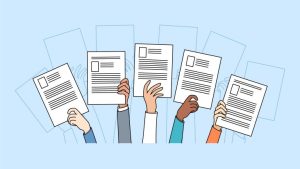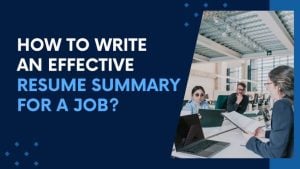How to Revamp Your Resume in 5 Steps
 Publié le 26 March 2024
Publié le 26 March 2024
Stand out to a crowded job market by learning how to revamp your resume in 5 steps.
One question that comes to mind when you want to revamp your resume is, “Where do I start?”
If it’s been a while since you updated your resume, you’ll need to highlight your new wealth of experience. If you’re changing careers, you’d need to emphasize transitional skills and strengths. In both cases, the process can be overwhelming, especially with the need to keep up with the latest resume trends.
So, how can you create a detailed resume that would impress hiring managers and get past specific Applicant Tracking Systems?
You’re in the right place. We’ll discuss how to revamp your resume in 5 steps.
Step 1: Remove Irrelevant Experiences and Include Quantifiable Metrics
Your work experience, also known as your work history, is the cornerstone of your resume. It’s usually the most extensive and time-consuming section, so starting here is best.
The goal is to quickly prove to the employer that you’ve excelled in recent roles that are similar to the job being advertised. Cluttering your resume with other things can bury employers’ points of interest and dissuade them from spending extra time on your resume.
That said, jumpstart the process of revamping your resume by weeding out the following:
- Unrelated roles: If you’re applying for a software engineer role with specific requirements but have retail sales associate experience cited in your resume — remove it. Unless you can tie in skills like coding, you’ll only be cluttering your resume.
- Old roles: Experience from 15 years ago, like an internship, might not be necessary when applying for a senior-level managerial role.
After you’ve streamlined your experiences to highlight those most relevant, take further steps to make them more captivating by aligning them with the company’s specific interests.
For this, take hints from the job description. Let’s say you’re applying for a customer support role and the job posting says:
“The ideal candidate must be able to handle a good number of customer queries per day while ensuring the quality of service provided. They should be able to think outside the box to ensure customer satisfaction. Experience in customer data entry and organization is also a must.”
Then phrase the relevant experiences on your resume the same way. Include industry-specific keywords as well to ensure your application gets through Applicant Tracking Systems (ATS) successfully.
Make sure for each relevant experience aligned with what the company is looking for, you also include quantifiable achievements. Companies hire employees because they have challenges to solve and goals to meet. To appeal to them, you’ll need to position yourself as someone who can help them. You can only do that if you show them results they can measure.
In a post, Austin Belcak, a LinkedIn Top Voice career coach, highlighted the impact of quantifiable metrics through the eyes of a recruiter or organization:
So, if you’re applying for the customer support job above, your resume with quantifiable results may look something like this:
Notice that in the resume above, these relevant experiences with quantifiable results are organized in bullet form. Why in bullet form? Because, assuming they’re traditional bullets and not some special character like diamonds, ATS systems can easily scan them. Plus, for people who like to just skim documents, this format is more digestible than the full-text format. Remember, if they’re not using an ATS platform, recruiters only spend six to eight seconds reviewing a resume.
Other best practices to remember when tailoring your relevant work experiences to the potential employer include:
- Listing your experience in reverse chronological order. Start with the most recent experience and move to the oldest.
- Start with action verbs to make sentences punchy.
If you aren’t confident in your writing or are pressed for time, consider using generative AI tools like Kick Resume, Rezi, or ChatGPT. Although there are generative AI risks like biased results, you can counter these by always double-checking and adjusting the tools’ outputs.
Step 2: Tweak Core Skill List
Again, just by looking at the job description, you can get an idea of the skills you need to include as part of your resume revamp to increase your chances of landing the job.
For the customer support role above, for instance, related skills such as customer data entry and organization will definitely get a recruiting manager’s attention. Any skills on your current resume that don’t align with what the company is looking for–like graphic design or video editing skills, for example—should again be removed. Don’t forget to also emphasize your proficiency in role-specific tech tools, especially the ones listed in the potential employers’ requirements. It further shows you’ll only need minimal training to fit into the role.
But when tweaking your core skill list based on what the potential employer wants, don’t just focus on your hard skills—or the job-specific skills you need to achieve quantified results in the role– such as the ones I mentioned above. A LinkedIn report found that 92% of hiring professionals agree soft skills–or transferable skills across different roles—matter as much or are more important than hard skills. Soft skill examples include communication and leadership skills.
So, make sure you again look at the job description to determine the soft skills you need to include in your resume as part of your revamp. For the customer support role example above, for instance, soft skills such as interpersonal communication and problem-solving can do the trick.
Step 3: Update Performance Summary
Your performance summary is a teaser for your experience and skills section. It should entice the employer to delve deeper into your resume.
Although it’s typically positioned at the beginning of your resume, an acceptable alternative is to write it last to ensure it accurately reflects your updated qualifications.
Keep this section concise, within two to three sentences. Start by introducing your expertise, then summarize your experience and skills. To make this section captivating, again, include measurable metrics.
Check out these examples:
Marketing:
Conversion-driven content marketer with 5+ years of experience. Skilled in diversifying content mix and creating thought leadership content to build authority. Recently drove a 200 percent increase in leads for a B2B company.
Sales:
Seasoned sales professional with 7+ years of experience. Proven track record of building and maintaining client relationships, resulting in a 45 percent increase in repeat purchases — skilled negotiator with a 75 percent contract closure rate.
Data analyst:
Accomplished data analyst with five years of experience transforming complex datasets into actionable insights. Proficient in data visualization, python, and SQL. Optimizing business processes by 45 percent through data-driven recommendations.
As with the rest of your resume, make sure you incorporate relevant keywords.
Step 4: Change Fonts and Layout
Fonts and layout contribute to the visual appeal of your resume. They can capture the recruiter’s attention and leave a positive first impression.
You might argue, well, my resume is visually appealing as it is. The thing is, if it was crafted way before ATS platforms became popular, you might have to make changes to these elements to ensure ATS readability. A staggering 70% of large or enterprise-level companies now use ATS to collect and screen resumes.
Complex or decorative fonts may be hard for the system to read, leading to formatting errors or missing information. While ATS may not require special fonts, simple fonts like Georgia, Arial, Times New Roman, Helvetica, and Caliber increase the chances of compatibility. It’s best to use not more than one font type so as not to confuse the ATS system.
Although font sizes don’t really matter for ATS systems, a 10- or 12-point font makes resumes look professional.
As for the resume layout, just ensure it’s clean and simple. Here are other tips to follow:
- Properly align bullet points for clarity.
- Use hierarchy in headings.
- Bold important information like job titles and company names to make them stand out.
You should limit your resume to two pages. But what if you have too many relevant experiences and skills? You can just include your link to a portfolio landing page with all the necessary information. Leadpages is a user-friendly tool for creating this type of landing page. It offers hundreds of templates to get you started. But if you find it expensive, try Landingi. It’s a Leadpages alternative with a 100 percent free plan.
Step 5: Update the File Name
Imagine meticulously revamping your resume to check all the company’s boxes, only for it to get lost in the employer’s system because you didn’t change the file name.
That’s how important updating the file name can be.
Just check the job description for the role you applied for. Some job postings may specify a naming resume format. All you need to do is follow it. Apart from the fact that this is key to ensuring your resume gets past a potential employer’s ATS system, it may also determine whether you advance in the hiring process. After all, the potential employer might also be testing your attention to detail and ability to follow instructions to the letter.
If there’s no prescribed resume naming format, use this:
“First name, last name, job title, resume.”
It’s professional and ensures that your complete resume appears if the recruiter searches by any filter using the ATS system. Avoid using special characters for compatibility across systems.
Keep Your Resume Up-to-Date
Resumes are important for job searches. If you want to stand out among the many other applicants for a job vacancy, you need to ensure yours aligns with what the potential employer is looking for. It should also successfully get through ATS systems employers now use today.
So, now you know how to revamp your resume in 5 steps. Remove irrelevant and old work experiences, tweak your core skill list, and update your performance summary. Don’t forget to change your font and layout to ensure readability. Finally, update your resume file name.
Now go forth with your revamped resume and land that perfect job for you. Best of luck!







